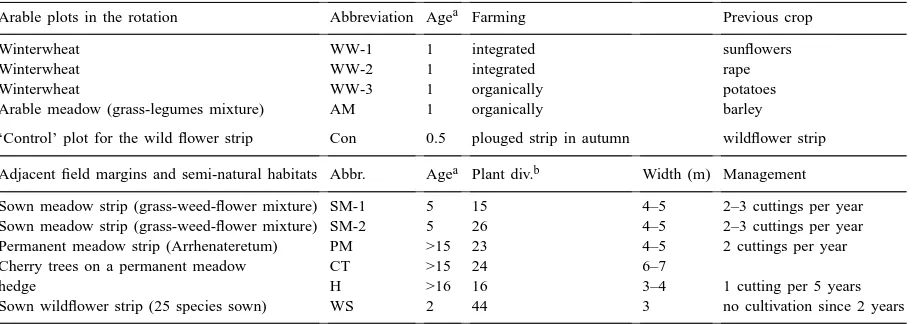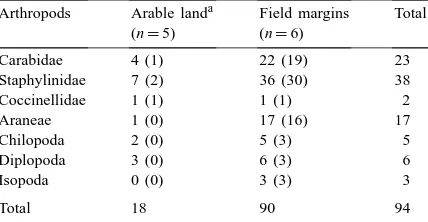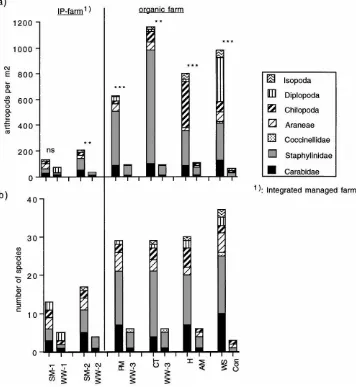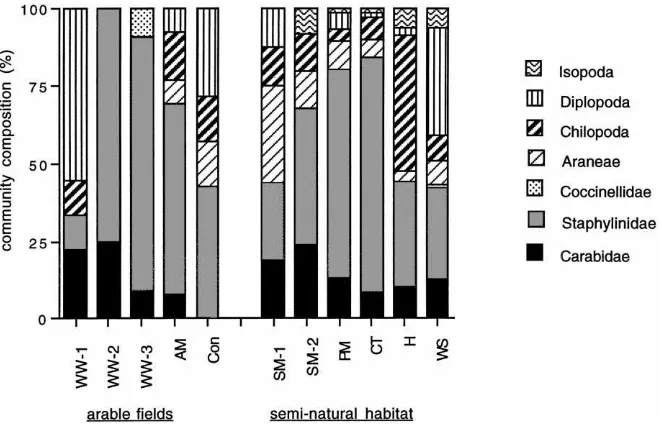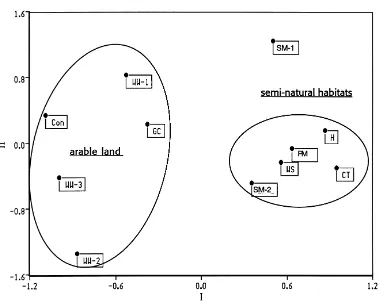Overwintering of arthropods in soils of arable fields and
adjacent semi-natural habitats
Lukas Pfiffner
∗, Henryk Luka
Research Institute of Organic Agriculture (FiBL), Ackerstrasse, CH-5070 Frick, Switzerland
Received 11 March 1999; received in revised form 12 August 1999; accepted 22 September 1999
Abstract
In order to determine the significance of field margins for the overwintering of arthropods in agricultural landscapes, different sites of an integrated and of an organically managed farm were investigated in the northwest of Switzerland. During December 1995 and January 1996, soil samples were taken with an electronic-hydraulic soil borer (depth: 25 cm, diameter: 8 cm). After hand sorting the larger arthropods, the small ones were extracted with a modified MacFadyen apparatus.
The abundance of arthropods in the arable fields was significantly lower than in the adjacent semi-natural habitats. Highest abundances and species diversities were found in a sown wildflower strip, a hedge, a permanent meadow and a meadow under the cherry trees of the organic farm. With a total of 90 arthropod species in the semi-natural habitats, five times more species were found than in the arable fields. Staphylinids, carabids, spiders and chilopods were the most abundant arthropod groups. The data showed that undisturbed semi-natural habitats and extensively managed field margins play a key role as overwintering sites for many predatory arthropods. ©2000 Elsevier Science B.V. All rights reserved.
Keywords: Overwintering; Arable land; Field margins; Semi-natural habitats; Beneficial arthropods; Switzerland
1. Introduction
In agricultural landscapes there is a general trend towards a reduction in diversity and abundance of native flora and fauna because of increased landscape uniformity and greater disturbance via farm inputs, cultivation and management (Burel, 1992; Pfiffner, 1997). Large disturbances, by both physical and chemical means, can reduce abundance and diversity of beneficial species, and ecosystem functions can be altered (Giller et al., 1997). Declines in the distribu-tion and abundance of beneficial arthropods because
∗Corresponding author. Tel.:+41-62-865-72-72; fax:+41-62-865-72-73.
E-mail address: [email protected] (L. Pfiffner).
of intensive farming methods have been documented in cornfields (Dritschilo and Erwin, 1982), potatoes (Kromp, 1989) and wheat (Pfiffner and Niggli, 1996). Since 1993, the Swiss government has subsi-dized sustainable farming methods including organic farming and the establishment of field margins and semi-natural habitats. One of the objectives of this subsidy is to halt the marked decline of biological diversity in agricultural landscapes. It is thus im-portant to evaluate the effects of diversity-enhancing techniques on cultivated land and its surroundings.
Field margins are important refuges for many plants and animals and thus play a key role in main-taining biological diversity on farmland (Fry, 1994). The size and type of field margins and associated semi-natural habitats play an essential role in the
survival of many invertebrates during winter. This has been shown for polyphagous pest predators, such as carabids, staphylinids and spiders (Sotherton, 1984; Wiedemeier and Duelli, 1993; Andersen, 1997). In arable land, these beneficial epigeic arthropods are important to reduce various pests (Cocquempot and Chambon, 1990; Symondson, 1993; Menalled et al., 1999). However, there is a lack of informa-tion about appropriate overwintering sites and the effects of different field margins on several groups of invertebrates.
The objective of this study was to compare the overwintering arthropod populations in arable fields with those in different adjacent semi-natural habitats and field margins (comparison in pairs). Two different landscapes were examined in the northwest of Switzer-land: a recently improved, integrated managed arable landscape with grassy field margins and since 1974 an organically managed farm in a richly structured land-scape.
2. Materials and methods
2.1. Study site
The climate at the study sites is relatively mild and dry with a mean precipitation of 785 mm per year and a
mean temperature of 9.5◦C. The altitude is 350–365 m
Table 1
Main characteristics of the investigation sites
Arable plots in the rotation Abbreviation Agea Farming Previous crop
Winterwheat WW-1 1 integrated sunflowers
Winterwheat WW-2 1 integrated rape
Winterwheat WW-3 1 organically potatoes
Arable meadow (grass-legumes mixture) AM 1 organically barley
‘Control’ plot for the wild flower strip Con 0.5 plouged strip in autumn wildflower strip
Adjacent field margins and semi-natural habitats Abbr. Agea Plant div.b Width (m) Management
Sown meadow strip (grass-weed-flower mixture) SM-1 5 15 4–5 2–3 cuttings per year Sown meadow strip (grass-weed-flower mixture) SM-2 5 26 4–5 2–3 cuttings per year Permanent meadow strip (Arrhenateretum) PM >15 23 4–5 2 cuttings per year
Cherry trees on a permanent meadow CT >15 24 6–7
hedge H >16 16 3–4 1 cutting per 5 years
Sown wildflower strip (25 species sown) WS 2 44 3 no cultivation since 2 years
aYears.
bNumber of plant species.
above sea level. The soil on both farms is a Luvisol from loess with similar soil properties.
On the integrated managed farm at Aesch, two win-ter wheat fields and two adjacent meadow strips were chosen (Table 1): The meadow strips 5 m in width (un-fertilized and mown twice per year) as well as hedges along the arable fields, were established 5 years ago to enrich the impoverished landscape. These strips were sown with a grass-clover mixture with 14 additional wildflowers (e.g., Centaurea jacea, Silene vulgaris, Chrysanthemum leucanthemum).
2.2. Sampling of arthropods
On three dates between December 1995 and January 1996, soil samples were taken at six paired habitats (arable or control plot and adjacent field margin) on the two farms described above. Twenty-four undisturbed soil cores were taken with an electronic-hydraulic soil borer (depth: 25 cm, diameter: 8 cm), randomly leav-ing about 8 m space between two consecutive samples at each site. Samples in the arable plots were taken in a line parallel to and 30 m distant from the field margins. After manually sorting the larger arthropods, the samples were placed in a modified MacFadyen apparatus for 4 days to extract the small arthropods (Bieri et al., 1978). Most arthropods were determined to species level including carabids larvae and juvenile spiders so far as possible. Finally, the 24 samples from each habitat were pooled.
2.3. Statistical methods
In each case the data showed that the arthropods were highly aggregated. Therefore, statistical analy-ses were done with pooled data from the three sam-pling dates. The comparison of paired arable field and adjacent semi-natural habitat was conducted with the Wilcoxon rank test. Arthropod community classifica-tion was established using an agglomerative hierar-chical clustering with the minimum variance method of Ward (Orloci, 1967; JMP Version 3). The species richness of each habitat was compared using an ordi-nation of the JACCARD similarity index with multi-dimensional scaling (NTSYS 1.8, Rohlf, 1993).
3. Results
The abundance of arthropods varied from 33 to 1163
individuals per m2 (Fig. 1). Lowest abundances and
species diversities were generally found in the arable
fields (33–107 ind./m2, 3–6 species). On the other
hand there was a wide range in the semi-natural
habi-tats (134–1163 ind./m2, 13–37 species). In all cases
the abundance of arthropods in the arable fields was significantly lower than in the adjacent semi-natural habitat, with only one exception (Wilcoxon rank test, Fig. 1). No differences in abundance were found within the arable fields and within the semi-natural
habitats at each site. Highest abundances and species diversities were found in the sown wildflower strip, hedge, permanent meadow and under the cherry trees on the organic farm (Fig. 1).
The more frequently found arthropod groups were pest predators, such as staphylinids, carabids, spiders and chilopods. Furthermore, large numbers of aggre-gated staphylinids were observed by a visual control near the south exposed parts of the cherry tree stems. Ninety of the 94 arthropod species found in all habitats were in semi-natural habitats; there were 18 species in the five arable fields; 75 species were exclusively found in the semi-natural habitats; and only four ex-clusively in the arable fields (Table 2).
Fig. 2 shows the community composition of the arthropods: the most even composition of the arthro-pod groups was in the sown meadows, hedge and wildflower strip. The staphylinids were the most abundant group in nearly all habitats. This domi-nance was particularly marked in the arable plots. The diplopods might be enhanced in wheat Plot 1 and in the 2-year-old wildflower strip because of rich litter layers there. In wheat Plot 1 this was because of a previous sunflower crop, which left much organic material on the soil.
Cluster analysis showed that the arthropod popula-tions of the semi-natural habitats on the organic farm were similar. All arable field samples formed one clus-ter, and the two sown grass-weed margins were in be-tween (Fig. 3). The higher species richness of field margins and their relative similarities were expressed in the two main clusters using an ordination of the JACCARD similarity index (Fig. 4).
Table 2
Total number of found arthropod species in arable land and adjacent field margins. Numbers in brackets are numbers of exclusively found species in the corresponding landscape category
Arthropods Arable landa Field margins Total (n=5) (n=6)
Carabidae 4 (1) 22 (19) 23
Staphylinidae 7 (2) 36 (30) 38
Coccinellidae 1 (1) 1 (1) 2
Araneae 1 (0) 17 (16) 17
Chilopoda 2 (0) 5 (3) 5
Diplopoda 3 (0) 6 (3) 6
Isopoda 0 (0) 3 (3) 3
Total 18 90 94
Fig. 1. Overwintering arthropods in arable fields and adjacent semi-natural habitats on two farms. (a) Densities of arthropod per m2; (b) number of arthropod species. Wilcoxon rank test, *: p<0.05, **: p<0.01, ***: p<0.001. Abbr. see Table 1.
4. Discussion
The results show that field margins which are not ploughed or otherwise disturbed during autumn or winter can act as refuges and hibernation sites for many arthropods. In the less intensively cultivated and more structured landscape of the organic farm, the abundance of arthropods was two to five times greater than in the plots of the integrated farm. The landscape of the organic farm was more diversified: smaller
Fig. 2. The community composition of the main arthropod taxa in arable fields and the adjacent semi-natural habitats. Abbr. see Table 1.
can positively influence the fecundity and feeding of beneficial arthropods (Bommarco, 1998). Bommarco found significant larger ground beetles (Poecilus cupreus) and a three times higher fecundity in a more complex and organically managed landscape than in a monotonous, conventionally farmed landscape in Sweden.
The mean density of more than 1100 arthropods per
m2 found in the extensive meadow under the cherry
trees is relatively high. Sotherton (1985) considered
Fig. 3. Arthropod community classification using an agglomerative hierarchical clustering with the minimum variance method of Ward. Abbr. see Table 1.
densities of 1000 epigeic polyphagous predators in field boundaries to be very high.
Fig. 4. The species richness of each habitat using an ordination of the JACCARD similarity index with multidimensional scaling. Abbr. see Table 1.
botanical characteristics of this strip would appear to be among the key factors. In addition, the colonization of diverse field margins by arthropods can be fairly rapid, as shown in the investigation by Thomas et al. (1994). In a similar study, Lys and Nentwig (1994) found a significantly higher density and species rich-ness of overwintering carabids, staphylinids and
spi-ders (mean density of 1300 ind./m2) in a 2-year-old
wildflower strip in comparison with an adjacent crop of winter barley.
High densities of overwintering polyphagous preda-tors have often been found in dense vegetation (e.g., Sotherton, 1985; Thomas et al., 1991). Furthermore, Desender (1982) showed a positive relation between the mean depth of sod layer in grass and the den-sities of overwintering carabids. The presented data from the ploughed wildflower strip (control plot with-out vegetation) showed that the vegetation was of de-cisive importance for the hibernation site selection
of many arthropods. One of the most important fac-tors inducing high densities of polyphagous predafac-tors seems to be the density or biomass of the vegetation layer; Bürki and Hausamann (1993) observed lowest densities of arthropods under plant species with lit-tle vegetation cover such as Agrostemma githago or Chenopodium polyspermum and very high densities of
predators (more than 2100/m2) under highly attractive,
larger plants such as Achillea millefolium and Arctium minus. These two last mentioned plant species were only present in the wild flower strip.
habitats. The temperature buffering properties of the semi-natural habitats could be a key abiotic factor in overwintering site selection.
Field margins can act as reservoirs for polyphagous arthropods. Indeed, during the overwintering pe-riod, top epigeic predators such as some staphylinid species (Paederus fuscipes, P. litoralis, Tachyporus chysomelinus, T. hypnorum, Xantholinus linearis, X. longiventris), ground beetles (Bembidion lampros, Agonum muelleri, Demetrias atricapillus) and 16 spider species were only found in the field margins. During the vegetation period, most of these species were also found in the adjacent arable fields (data not published). This contrasts partly with the findings of Andersen (1997) in Norway. On the one hand, he showed that most carabid and staphylinid species were significantly more abundant in field margins than in the adjacent cereal fields. On the other hand, he concluded that the grass field margins were of lim-ited importance as a reservoir for predatory beetles, because he found the ground beetle Clivina fossor and staphylinids of the genus Lathrobium distributed evenly over field margins and cereal fields.
In addition, Hawthorne et al. (1998) showed that un-cropped wildlife strips could enhance the abundance of polyphagous predators within the field because they can act as an additional source of colonizing individu-als (e.g., Bembidion lampros) and thus do not create a barrier to the movement. This fact underlines their rel-evance for the biological control of pests in adjacent fields. However, there are data of Mauremootoo et al. (1995) which show reducing effects of hedgerows on the dispersal of carabid beetles between fields.
Another relevant feature is the spatial distribution of arthropods within field margins. Riedel (1995) found a preference by field inhabiting carabids such as Bembidion lampros and B. tetracolum as well as for all pooled carabids for the edge (ecotone) of uncultivated grass vegetation. No significant distribution preference was observed for Amara familiaris, A. plebeja and Tachyporus hypnorum. These flying and larger species are known to overwinter often in the hedgerows.
5. Conclusions
Semi-natural habitats are important overwintering sites for arthropods and can significantly enhance the
number of species and the abundance of beneficial arthropods on arable land. They can fulfill multiple ob-jectives in agroecology and nature conservation. This is encouraged by structural complexity, botanical di-versity and the permanent vegetation layer in these habitats.
Acknowledgements
The authors thank Dr. A. Haenggi (Natural History Museum, Basel) for use of the MacFadyen apparatus; T. Blick (spiders), Dr. C. Huber (carabids larvae), J. Spelda (myriapods), S. Kiener (staphylinids) for species determinations and the farmers for providing their fields; and the Basellandschaft canton adminis-tration and the Swiss Agency for the Environment, Forests and Landscape for financial support. Thanks also go to Prof. Dr. P. Duelli, Dr. B. Speiser, Dr. P. Mäder and P. Damary for their helpful comments on the manuscript and the anonymous referees and an Editor-in-Chief for improvements to an earlier version of this paper.
References
Andersen, A., 1997. Densities of overwintering carabids and staphylinids (Col., Carabidae and Staphylinidae) in cereal and grass fields and their boundaries. J. Appl. Entomol. 121, 77–80. Bieri, M., Delucchi, V., Lienhard, C., 1978. Ein abgeänderter MacFadyen-Apparat für die dynamische Extraktion von Bodenarthropoden. Mitt. Schweiz. Entomol. Gesellschaft. 51, 119–132.
Bommarco, R., 1998. Reproduction and energy reserves of a predatory carabid beetle relative to agroecosystem complexity. Ecol. Applications 8, 846–853.
Burel, F., 1992. Effect of landscape structure and dynamics on species diversity in hedgerow networks. Landscape Ecol. 6, 161–174.
Bürki, H.M., Hausamann, A., 1993. Überwinterung von Arthropoden im Boden und an Ackerkräutern künstlich angelegter Ackerkrautstreifen. Agrarökologie 7, 1–158. Cocquempot, C., Chambon, P., 1990. Le role des prédateurs
polyphages dans la dynamique des populations des pucerons du blé dans la région parisienne Etude expérimentale. Schweiz. Landw. Fo. 29, 155–168.
Desender, K., 1982. Ecological and faunal studies on Coleoptera in agricultural land II. Hibernation of Carabidae in agro-ecosystems. Pedobiologia 23, 295–303.
Fry, G.A., 1994. The role of field margins in the landscape. In: Boatman, N. (Ed.), Field margins: Integrating agriculture and conservation. Brit. Crop Protec. Council Mono. 58, 31–40. Giller, K.E., Beare, M.H., Lavelle, P., Izaac, A.-M.N., Swift,
M.J., 1997. Agricultural intensification, soil biodiversity and agroecosystem function. Appl. Soil Ecol. 6, 3–16.
Hawthorne, H.J., Hassall, M., Sotherton, N.W., 1998. Effects of cereal headland treatments on the abundance and movements of three species of carabid beetles. Appl. Soil Ecol. 9, 417– 422.
Kromp, B., 1989. Carabid beetle communities Carabidae, Coleoptera in biologically and conventionally farmed agroecosystems. Agric. Ecosyst. Environ. 27, 241–251. Lys, J.-A., Nentwig, W., 1994. Improvement of the
overwintering sites for Carabidae, Staphylinidae and Araneae by strip-management in a cereal field. Pedobiologia 38, 238– 242.
Mauremootoo, J.R., Wratten, S.P., Worner, S.P., Fry, G.L.A., 1995. Permeability of hedgerows to predatory carabid beetles. Agric. Ecosyst. Environ. 52, 141–148.
Menalled, F.D., Lee, J.C., Landis, D.A., 1999. Manipulating carabid beetles abundance prey removal rates in corn fields. BioControl 43, 441–456.
Nentwig, W., 1995. Sown weed strips – an excellent type of ecological compensation area in our agricultural landscape. First ENOF Workshop: Land Use and Biodiversity: The role of Organic Farming, Isart, J., Llerena, J.J. (Eds.), 8–9 December 1994, Bonn, Germany.
Orloci, L., 1967. An agglomerative method for the classification of plant communities. J. Ecol. 55, 193–206.
Pfiffner, L., 1997. Welchen Beitrag leistet der ökologische Landbau zur Förderung der Kleintierfauna? In: Weiger, H.,
Wiler, H., (Eds.), Naturschutz durch ökologischen Landbau, DEUKALION, Verlag, pp. 93–120.
Pfiffner, L., Niggli, U., 1996. Effects of bio-dynamic, organic and conventional farming on ground beetles (Col. Carabidae) and other epigaeic arthropods in winter wheat. Biol. Agric. Hortic. 12, 353–364.
Rohlf, F.J., 1993. NTSYS-pc. Numerical taxonomy and multivariate analysis system, New York (Exeter).
Riedel, W., 1995. Spatial distribution of hibernating polyphagous predators in field boundaries. In: Toft S., Riedel, W., (Eds.), Arthropod Natural Enemies in Arable Land. Aarhus University Press, Aarhus, pp. 221–226.
Sotherton, N.W., 1984. The distribution and abundance of predatory arthropods overwintering on farmland. Ann. Appl. Biol. 105, 423–429.
Sotherton, N.W., 1985. The distribution and abundance of predatory arthropods overwintering in field boundaries. Ann. Appl. Biol. 106, 17–21.
Symondson, W.O.C., 1993. The effects of crop development upon slug distribution and control by Abax parallelepipedus Coleoptera, Carabidae. Ann. Appl. Biol. 123, 449–457. Thomas, C., Cooke, H., Bauly, J., Marshall, E., 1994. Invertebrate
colonisation of overwintering sites in different field boundary habitats. Asp. Appl. Biol. 40, 229–232.
Thomas, M.B., Wratten, S.D., Sotherton, N.W., 1991. Creation of ‘island’ habitats in farmland to manipulate populations of beneficial arthropods: predator densities and species composition. J. Appl. Ecol. 28, 906–917.
